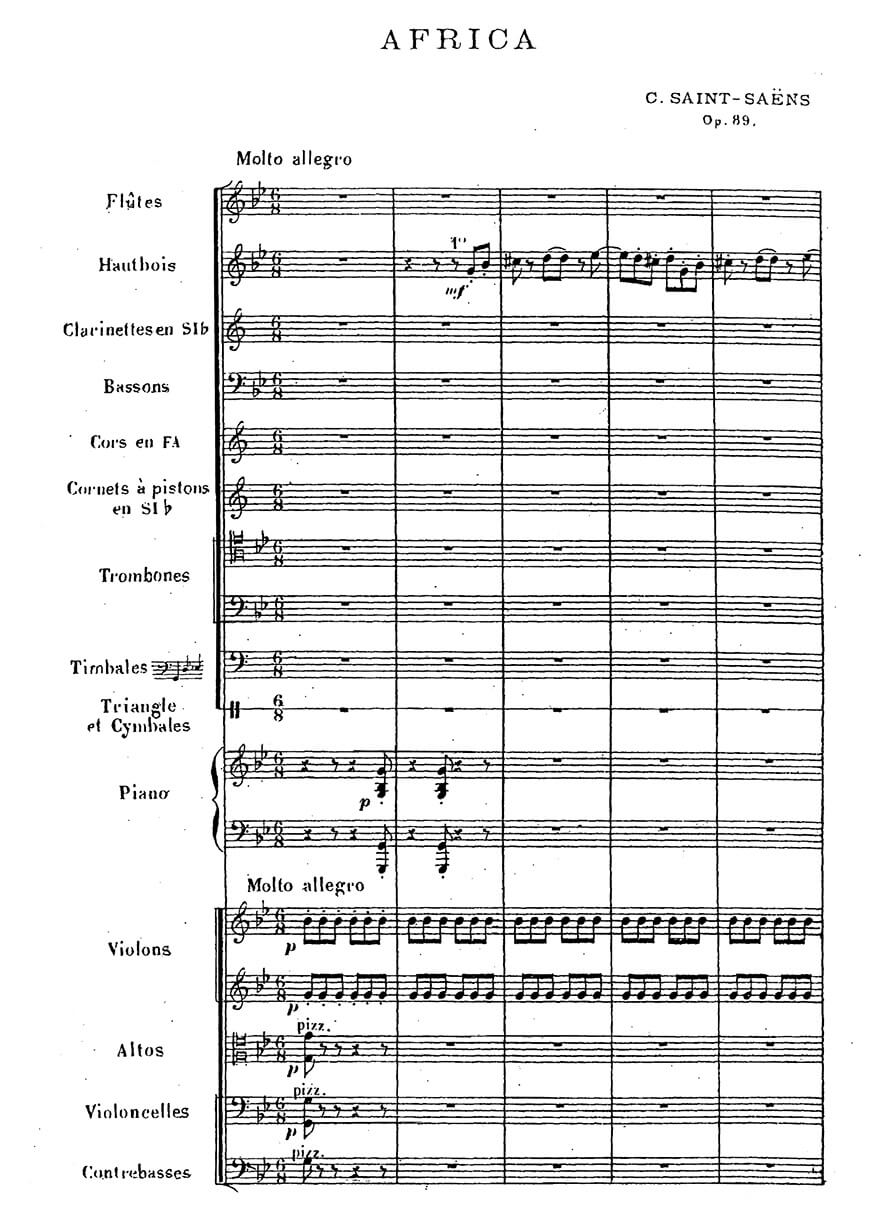Africa, Fantaisie pour piano avec accompagnement d’Orchestre, Op. 89
Saint-Saëns, Camille
30,00 €
Preface
Camille Saint-Saëns – Africa, fantaisie pour piano avec accompagnement d’Orchestre, op. 89 (1891)
(b. Paris, 9 October 1835 – d. Algiers, 16 December 1921)
(Images in the online preface are not available!)
Composed: started 1889 Cadiz, completed March-April 1891 Cairo, orchestrated June 1891 in Algiers
Premiere: 25 October 1891, conducted by Édouard Colonne (1838-1910) at the Théâtre du Châtelet Concerts Colonne
Dedicated to: Mademoiselle Marie-Aimée Roger-Miclos (1860-1951), premiering pianist.
First Publication: October 1891, Two pianos: Durand & Schoenewerk, Plate D. & S. 4394
November 1891 Orchestral parts: Durand & Cie., Plate D. & F. 4476
December 1891 Solo piano: Plate D. & S. 4440
February 1892 Orchestral score: Durand & Cie., Plate D. & F. 4476
Orchestration: 2 flutes, 2 oboes, 2 clarinets, 2 bassoons, 2 horns (F), 2 cornets (B-flat), 3 trombones, timpani, triangle, cymbals, strings
The Composer
Camille Saint-Saëns was a short, witty, sarcastic French composer remembered mainly for his opera Samson and Delilah and the orchestral showpieces Danse macabre and Carnival of the Animals. One of the most prolific French romantic composers, he published nearly 300 compositions in his eighty-six years, describing himself as “an apple tree producing apples”. He composed the first film score in 1908.
Saint-Saëns began as a child prodigy, picking out tunes on the piano at two and making a public début as a pianist at five. Soon after, his parents took him to a Parisian symphony concert; he enjoyed the string serenade, but cried out at the brass entrance, “Make them stop. They prevent my hearing the music.” He was removed. The young man developed into an enthusiastic admirer of ballet and liked to dance socially. He entered the Paris Conservatoire at age fifteen, winning prizes in every class and studying under the Parisian-Jewish composer Jacques Halevy (1799-1862). Charles Gounod and Georges Bizet (who married Halévy’s daughter) were his closest friends at the Conservatoire. All three young composers publicly admired the progressive elements of Berlioz, Liszt, and especially Wagner’s music, but their compositions tended to be characterized as arch-conservative for their opposition to Debussy, late Strauss, and Stravinsky (Saint-Saëns walked out of the premiere of Le sacre du printemps). From 1857-1877, he worked as Head Organist at the famed Madeleine Church in Paris. Franz Liszt remarked, “His organ playing was not merely of the first rank, but incomparable…no orchestra is capable of creating a similar impression.” Notable works from this period include piano concertos (No. 2 inspiring Ravel’s jazzy G Major Piano Concerto) and Samson et Dalila, which Liszt sponsored in Weimar. …
read more / weiterlesen … > HERE
Score Data
| Score Number | 4871 |
|---|---|
| Edition | Repertoire Explorer |
| Genre | Keyboard & Orchestra |
| Pages | 106 |
| Size | 210 x 297 mm |
| Printing | Reprint |
